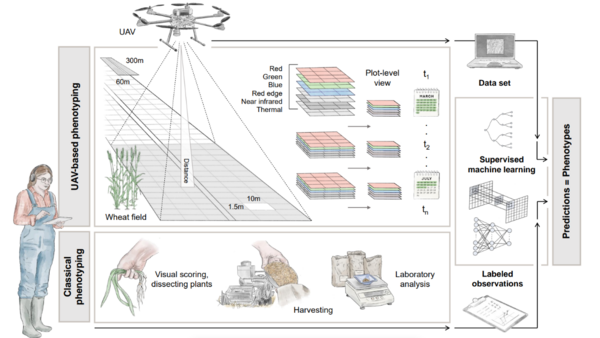Jules Salzinger, an artificial intelligence expert at AIT, was recently a guest on the Austrian Artificial Intelligence Podcast, where he talked about his research in AI-powered remote sensing phenotyping in agriculture. The podcast was an opportunity for him to showcase the latest research and the automated phenotyping model he helped develop.
Salzinger is a research engineer at the Competence Unit Assistive & Autonomous Systems of the AIT Center for Vision, Automation & Control. Due to his expertise, he was recently appointed to the AI Task Force, which aims to transform the AIT into a company with comprehensive and consistent AI support in all areas. AI is bringing about numerous disruptive changes in the research and innovation sector. It is therefore essential for AIT to promote AI-supported work in order to position itself at the forefront of applied research in Europe. The AI Task Force is designed to pave the way to achieving this. In his role, Salzinger focuses on community building and AI education, making him a key player in AIT's AI strategy.
In the podcast, Salzinger presented the paper 'TriNet: Exploring More Affordable and Generalisable Remote Phenotyping with Explainable Deep Models', which he co-authored. The paper describes a scalable deep learning method for detecting yellow rust, a yield-reducing fungal disease in winter wheat, using multispectral images taken by UAVs. By reducing the data volume by a factor of 3 to 4, the model enables more efficient phenotyping without sacrificing precision. Particularly noteworthy is the explainability of the model, which provides valuable insights for agronomists and plant breeders.
This approach shows how cost-effective and scalable solutions can be developed for agricultural science. At the same time, it highlights the potential of artificial intelligence in modern research.
We congratulate Jules Salzinger on this successful podcast episode!
To listen, click here
Beltrame L, Salzinger J, Koppensteiner LJ, Fanta-Jende P. TriNet: Exploring More Affordable and Generalisable Remote Phenotyping with Explainable Deep Models. Drones. 2024; 8(8):407. https://doi.org/10.3390/drones8080407
Click here for more information about the WheatVIZ project (german)



